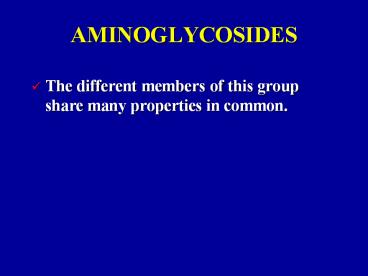AMINOGLYCOSIDES - PowerPoint PPT Presentation
Title:
AMINOGLYCOSIDES
Description:
The different members of this group share many properties in common. AMINOGLYCOSIDES Streptomycin Gentamicin Tobramycin Amikacin Netilmicin Kanamycin Neomycin ... – PowerPoint PPT presentation
Number of Views:1072
Avg rating:3.0/5.0
Title: AMINOGLYCOSIDES
1
AMINOGLYCOSIDES
- The different members of this group share many
properties in common.
2
(No Transcript)
3
AMINOGLYCOSIDES
- Streptomycin
- Gentamicin
- Tobramycin
- Amikacin
- Netilmicin
- Kanamycin
- Neomycin
4
AMINOGLYCOSIDES
- Amino sugars linked through glycosidic bonds.
- Polycations This is in part responsible for many
of their shared pharmacokinetic properties
5
ANTIBACTERIAL ACTIVITY
- Primarily active against aerobic gram negative
bacteria. - Active against many staphylococci and certain
Mycobacteria. - Anaerobic bacteria are not susceptible.
6
SENSITIVITY AND RESISTANCE
7
AMINOGLYCOSIDE TRANSPORT
- Transport across the cell membrane is by active
transport. - Antimicrobial activity is reduced in an anaerobic
environment and at low pH.
8
RESISTANCE
- Cross-resistance occurs to varying degrees with
the different aminoglycosides. - Amikaciin
9
ABSORPTION AND DISTRIBUTION
- Oral bioavailability is low.
- Once daily dosing (postantibiotic effect).
- Distribution into most body tissues including the
CNS is low.
10
EXCRETION
- Rapidly and almost entirely excreted by
glomerular filtration (proportional to creatinine
clearance). - Accumulation occurs with impaired renal function.
11
(No Transcript)
12
(No Transcript)
13
PHARMACOKINETICS
- Monitor the serum concns of the drugs (T.I. is
close to 1).
14
THERAPEUTIC USES
- Severe , complicated infections.
- Often combined with ß-lactams.
15
STREPTOMYCIN
- Bacterial endocarditis (combined with a
penicillin or vancomycin). - Tuberculosis.
16
Gentamicin, Tobramycin, Netilmicin and Amikacin
- Similar in clinical indications and range of
activity. - Gentamicin is often preferred but resistance may
limit its use.
17
THERAPEUTIC USES
- Serious gram negative infections especially those
due to Pseudomonas, Enterobacter, Klebsiella,
Serratia etc. - UTIs, bacteremia, meningitis, infected burns,
pneumonia, osteomyelitis, ear infections etc.
18
THERAPEUTIC USES
- Severe Pseudomonas infections are best treated
with one of these 4 AGs plus an antipseudomonal
penicillin or cephalosporin. - Gentamicin combined with a penicillin is often
used to treat bacterial endocarditis.
19
THERAPEUTIC USES
- Tobramycin is often used in pseudomonal
infections. - Amikacin is used as the preferred agent in
hospitals. - Netilmicin- may be useful in resistant
infections.
20
DRUG INTERACTIONS
- Antipseudomonal penicillins inactivate
aminoglycosides. - Ethacrynic acid and other loop diuretics.
- Nephrotoxic agents.
- Neuromuscular blocking agents.
21
(No Transcript)
22
SHARED PROPERTIES OF THE AMINOGLYCOSIDES
Inhibit protein synthesis by binding to the 30S ribosomal subunit
Pharmacokinetics-Poorly absorbed from the GI tract, Dont get into the CNS very well, Rapidly excreted by kidney
Toxicity-Ototoxicity, Nephrotoxicity, Neuromuscular blockade
23
THERAPEUTIC USES OF THE AMINOGLYCOSIDES
Streptomycin T.B., Endocarditis
Gentamicin Endocarditis, gram negative infections, Pseudomonas
Tobramycin Gram negative infections, Pseudomonas
Amikacin Reserve drug for gram negative- infections
24
Wheel of Bugs
Gram-negative
H. influenzae
Neissseria spp
E. Coli (coliforms)
Bacteroides spp
P. aeruginosa
Anaerobic
Clostridium spp
S. aureus
Streptococcus spp
Enterococcus spp
Gram-positive
25
MECHANISM OF ACTION
- Bactericidal.
- They inhibit protein synthesis by binding
irreversibly to the 30S ribosomal subunit.
26
A
50S
Nascent polypeptide chain
Transferase site
aa
mRNA
template
P
AGs
30S
Mechanism of action of Aminoglycosides
27
Mature protein
Blocks initiation
Growing polypeptide
50S
Premature termination
5
3
Wrong amino acid is incorporated
30S
5
mRNA translation
aminoglycoside
Effects of Aminoglycosides
28
Aminoglycosides on Protein Synthesis
Mature Protein
Growing Polypeptide
50S
AUG
3
5
30S
mRNA translation
Amino Glycoside
29
MECHANISM OF ACTION
- Exact mechanism of cell death is unknown.
- Postantibiotic effect.
30
RESISTANCE
- Alterations in ribosomal proteins.
- Decreased permeability to the antibiotic.
- Induction of bacterial enzymes that inactivate
these drugs.
31
RESISTANCE
- Alterations in ribosomal proteins.
- Decreased permeability to the antibiotic.
32
(No Transcript)
33
TOXICITY
- Ototoxicity (Vestibular and Auditory).
- Nephrotoxicity.
- Neuromuscular Blockade.
34
(No Transcript)
35
OTOTOXICITY
- The most serious toxic effect (uncommon,
irreversible and cumulative). - Caused by all the aminoglycosides
36
OTOTOXICITY
- Both auditory and vestibular dysfunction can
occur. - Results from destruction of sensory hair cells.
37
(No Transcript)
38
OTOTOXICITY
- Several factors increase the risk.
- Careful monitoring is important.
39
(No Transcript)
40
(No Transcript)
41
NEPHROTOXICITY
- Aminoglycosides accumulate in the renal cortex
(mainly proximal tubules). - Several factors may increase the risk.
- Reversible and usually mild.
- Reduced excretion can lead to ototoxicity.
42
NEPHROTOXICITY
- Several factors may increase the risk.
- Reversible and usually mild.
- Reduced excretion can lead to ototoxicity.
43
NEUROMUSCULAR BLOCKADE
- Rare but potentially serious.
- Occurs at high concentrations of aminoglycosides
or in patients with an underlying risk factor. - Acute neuromuscular blockade, respiratory
paralysis and death can occur.
44
(No Transcript)
45
NEUROMUSCULAR BLOCKADE
- Results from decreased ACH release and decreased
postsynaptic sensitivity. - Treated with supportive measures and calcium (or
neostigmine).































